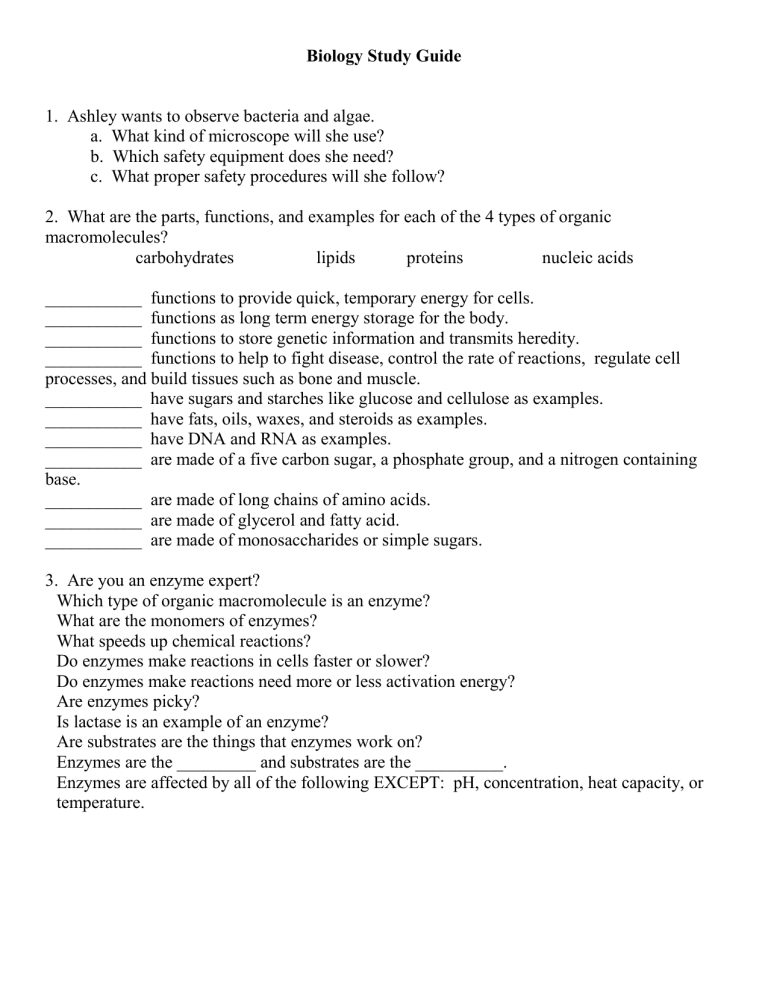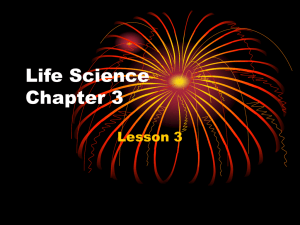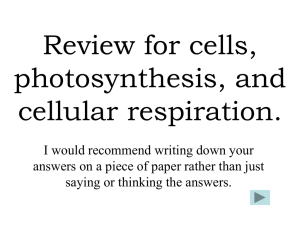
Biology Study Guide 1. Ashley wants to observe bacteria and algae. a. What kind of microscope will she use? b. Which safety equipment does she need? c. What proper safety procedures will she follow? 2. What are the parts, functions, and examples for each of the 4 types of organic macromolecules? carbohydrates lipids proteins nucleic acids ___________ functions to provide quick, temporary energy for cells. ___________ functions as long term energy storage for the body. ___________ functions to store genetic information and transmits heredity. ___________ functions to help to fight disease, control the rate of reactions, regulate cell processes, and build tissues such as bone and muscle. ___________ have sugars and starches like glucose and cellulose as examples. ___________ have fats, oils, waxes, and steroids as examples. ___________ have DNA and RNA as examples. ___________ are made of a five carbon sugar, a phosphate group, and a nitrogen containing base. ___________ are made of long chains of amino acids. ___________ are made of glycerol and fatty acid. ___________ are made of monosaccharides or simple sugars. 3. Are you an enzyme expert? Which type of organic macromolecule is an enzyme? What are the monomers of enzymes? What speeds up chemical reactions? Do enzymes make reactions in cells faster or slower? Do enzymes make reactions need more or less activation energy? Are enzymes picky? Is lactase is an example of an enzyme? Are substrates are the things that enzymes work on? Enzymes are the _________ and substrates are the __________. Enzymes are affected by all of the following EXCEPT: pH, concentration, heat capacity, or temperature. 5. Compare and contrast the two cell types. Prokaryote (Bacteria) Eukaryotes (Plant, Animal, etc.) 5. 6. Compare the structures (organelles) and functions (jobs) of the various cell types and kingdoms. ________ endoplasmic reticulum a) Contains chlorophyll to help cell trap light to make food ________ nucleus b) Tube network in cytoplasm where cell substances ________ ribsosomes are made ________ nuclear membrane c) Controls movement of material in and out of the ________ cytoplasm nucleus ________ chromosomes d) Controls cell activities ________ cell membrane e) Contains cell materials ________ mitochondria f) Surrounds plant cells; gives shape and support to ________ Golgi bodies cell ________ vacuole g) Proteins are made in these ________ chloroplast h) Rod-shaped bodies that release energy for cell use ________ cell wall i) Bodies that store and release proteins j) Controls movement of materials into and out of cell k) Holds the code that controls cell l) Stores water and material in plant cells 7. What 4 cell parts must all organisms have? 8. Cell Transport a. What is diffusion? b. What is the difference between active and passive transport? c. What is metabolism? d. What is a solute and a solvent?. e. Name the difference between hypotonic, hypertonic and isotonic? Concentration of Water and Solutes in Four Adjacent Cells f. Refer to the illustration above. In this system, water molecules are most likely to diffuse in which direction? Describe what happens as particles move from one side to the others. g. Refer to the illustration above. In this system, dissolved particles in cell B are most likely to h. Name 3 types of Active Transport? i. What is the difference between Endocytosis and exocytosis 8. Evaluate the role of natural selection in the development of the theory of evolution. a. Trace the history of the theory. _____ Lamarck _____ Wallace _____ Darwin _____ Malthus A. He wrongly believed that organisms could acquire a trait like a giraffe needing a long neck to eat tree leaves and their babies would inherit this new characteristic. B. He predicted that the human population would grow faster than the space and food supplies needed to sustain it. C. He also came up with ideas on evolution based on natural selection from his studies of the distribution of plants and animals. D. He presented a new view of life including his theory of evolution of species by natural selection and other related concepts like survival of the fittest and common descent. 9. Explain the history of life in terms of biodiversity, ancestry, and the rates of evolution. What does the picture suggest about the animals in it? a. Explain how fossil and biochemical evidence support the theory. b. Relate natural selection to changes in organisms. c. Name the 3 types of Natural Selection d. Name the 2 types of genetic drift? e. What is gene flow and name the 2 ways in occurs. f. What is speciation? g. Name the types of isolation needed for speciation to take place? 10.In the cladogram below which are the derived characters? 11.Name the clades that are most similar? 12.Which clade is most like Vertebrates? 13. Photosynthesis. a. What are the three parts of an ATP molecule? ____________________________-, ___________________________ and 3 _____________ groups b. What is the process that plants use to make glucose called? ____________________________ c. Where in plants does photosynthesis take place? _______________________ d. Where do the light-dependent reactions take place in the chloroplast? ________________________________ e. Another name for the light independent reaction is the _____________________ _________________ f. What is the final product in the dark reaction of photosynthesis? _____________________ g. Which kinds of organism can do photosynthesis? h. What cell parts must these organisms have? i. What are the reactants? j. What are the products? 14. Cellular Respiration a. Which kinds of organism can do cellular respiration? b. What type of respiration occurs in the presence of oxygen? ________________________________ c. What type of respiration occurs in the absence of oxygen? ________________________________ d. Put the following in the correct sequence of events in cellular respiration. ________Krebs Cycle __________ Electron Transport _________ Glycolysis e. What is Glycolysis? f. What are the two types of fermentation? g. What are the products of cellular respiration h. What is the equation for Cellular respiration? i. During fermentation in muscle cells, what chemical is formed? _________________________ a. Identify which occurs in the cytoplasm ___________________________ b. Identify which occurs in the mitochondria ___________________________ c. All three pathways begin with what process? ________________________________ d. Based on Figure 9-1, ____________________ ATP molecules are formed by fermentation. e. In Figure 9-1, only the pathway labeled ____________________ requires oxygen. f. How many ATP is formed during cellular respiration? ___________________ 15. Mitosis/Meiosis a. What happens in each of the phases of the cell cycle? b. What are the phases of mitosis in their proper sequence? c. What are chromatids? d. What are sister chromatids? e. How does the number of chromosomes in the parent cell compare to the number of chromosomes in a daughter cell formed using the process of mitosis? f. What did Gregor Mendel use pea plants to study? Why peas? g. What are the two main stages of cell division called? h. What type of organic compound is the main source of energy for living things? i. What process makes gametes? j. What is the relationship between an organism’s diploid number and its haploid number? k. What does meiosis form? l. In humans, how many chromosomes are found in somatic (body) cells? m. What is the shape of a molecule deoxyribonucleic acid? 16. Genetics a. What are Mendels 3 laws of inheritance? b. Explain crossing over and tell when it occurs? c. what are various forms of a gene at different loci? d. Know the definitions and how they apply to genetics. homozygous and heterozygous genotype and phenotype co-dominant incomplete dominant dihybrid cross multiple alleles e. what are the diploid and haploid number of chromosomes? f. What type of dominance is shown in sickle cell anemia g. What are the three alleles for blood typing? h. What are sex-linked traits? i. Monohybrid cross: In certain trees, smooth bark is dominant over wrinkled. Cross two trees that are heterozygous for smooth bark. If there are 100 offspring produced, how many will have wrinkled bark? j. Monohybrid cross: In Mountain Boomers, the genes for length of tail exhibit "incomplete" dominance. Use a Punnett Square to predict the result of a cross between a homozygous Long-tailed and a homozygous Short-tailed Mountain Boomer. What do the offspring look like? k. Dihybrid cross: In certain bacteria, an oval shape is dominant over round and thick cell walls are dominant over thin. Cross a heterozygous oval, thick cell walled bacteria with a round, thin cell walled bacteria. Describe the phenotype of the offspring. 17. . The diagram below shows a simplified nitrogen cycle. Which process is responsible for returning nitrogen to the air? 18. A single prokaryotic cell can divide several times in an hour. Few eukaryotic cells can divide as quickly. What best explains this difference? 19. Explain the diagram on the right. 20. The energy in the food produced by autotrophs or taken into the bodies of heterotrophs must be changed into a form that cells can use. The energy-transferring molecule used by cells is: 21. In the food web below, which organisms are secondary consumers? 22. How many producers are shown in the food web above? 23. How many Kilocalories (Kcal) can the primary consumer in the figure below store? 24. Wading birds such as herons and egrets have evolved long legs because the environment around the rivers and marshes has increased competition between wading birds. Short legged birds had to start wading into deeper water in order to survive. This forced the birds to stretch their legs to avoid being knocked over by the little waves. This stretching caused their legs to get a little longer. This is an explanation that ________ might have given. a. Lamarck b. Wallace c. Darwin d. Malthus 25. Complete the concept map below. 26. In humans, the pelvis and femur or thigh bone are involved in walking. In whales, the pelvis and femur shown in the photo below are: 27. Modern sea star larvae resemble some primitive vertebrae larvae. This similarity may suggest that primitive vertebrates share a _____________ ________________ with sea stars. 28. What do all members of a population share? 29. Which of the following genotypes result in the same phenotype? a. IAIA and IAIB b. IBIB and IBi c. IBIB and IAIB d. IBi and ii 30. In corn, there is complete dominance. In the shown to the right, which of the following squares phenotype? Punnett square represent the same 31. Colorblindness is more common in males than allele colorblindness is ______________ and located chromosome. females because the on the X 32. Two spotted leopards produce a litter of four cubs. Three of the cubs are spotted and one is solid black. The black coat is probably what type of trait? 33. The diagram to the right shows a strand of DNA strand of messenger RNA. What process does this represent? matched to a diagram 34. DNA that is derived from the DNA of two or more different species is called: 35. What kind of cell (or cells) are used to make a cloned mammal? 36. This karyotype (photo on right) is unusual because chromosome set: a. 5 has chromosomes of different shapes b. 10 is missing genetic material c. 21 has extra genetic material d. 14 has enlarged centromeres 37. The purpose of gene therapy is to ____________________ ___________________________________________. 38. One way to increase the number of organisms in an endangered species is to let the few remaining individuals of that that species breed. However, this breeding may also lead to species extinction because inbreeding over a short period of time may reduce genetic ___________________. 39. Explain the flow of matter and energy through ecosystems by drawing and/or interpreting each of the following nutrient 40. Explain the flow of matter and energy through ecosystems by drawing and/or explaining ATP/ADP cycling.



